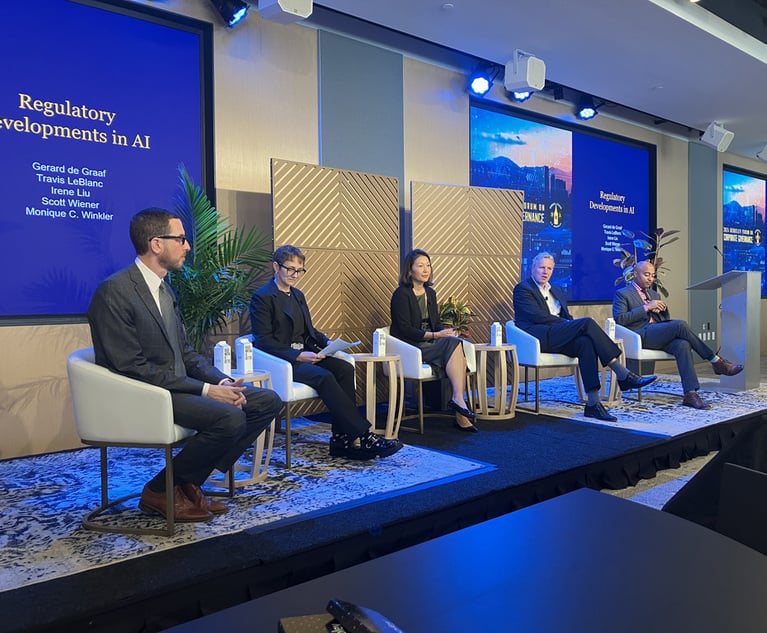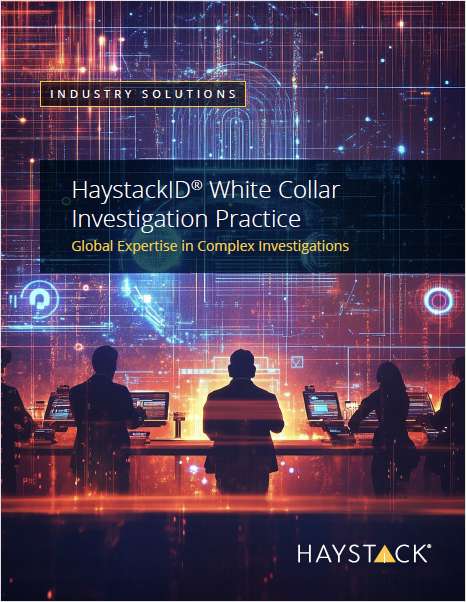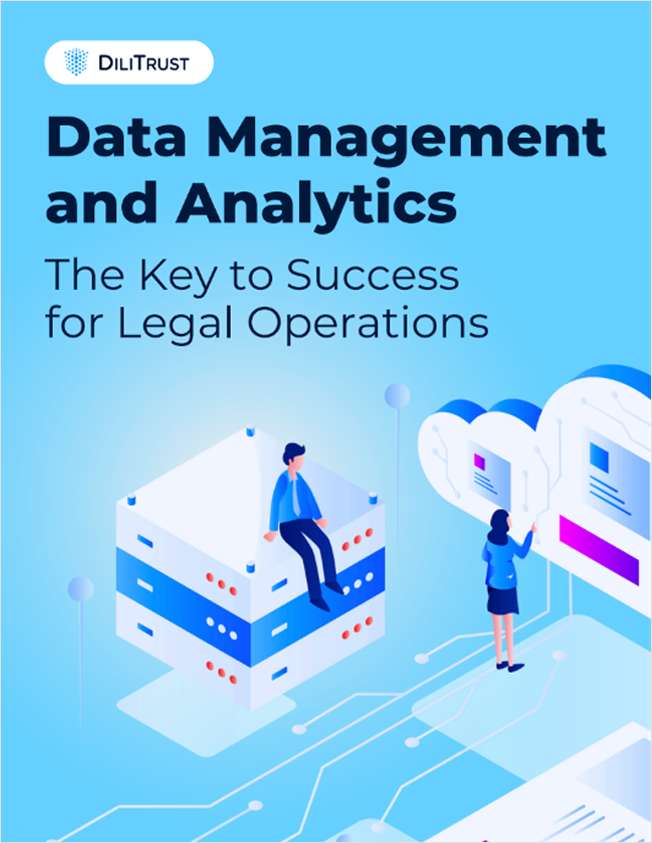Inside Experts: Understanding your e-discovery pain tolerance
In the May issue of InsideCounsel, Kayleigh Roberts and Ashley Trent wrote an excellent…
June 17, 2011 at 04:55 AM
7 minute read
The original version of this story was published on Law.com
In the May issue of InsideCounsel, Kayleigh Roberts and Ashley Trent wrote an excellent article titled “Keeping Up With Evolving E-Discovery.” The article referenced an array of “how-to” tactics and best practices for bringing electronic discovery in-house. However, before corporations jump into the “hows” of e-discovery, they should first focus on the ”whys”—meaning, why bring electronic discovery in-house in the first place? For many serial litigants or companies in regulated verticals, taking e-discovery in-house is a fait accompli. But for many other enterprises, a bit of soul-searching will be useful before embarking upon the insourcing journey. In the event that the “why” isn't well-defined before evaluating products and vendors, the resulting process may ultimately be a futile effort as diverging interests surface at inopportune times.
Evaluate your pain index
It's probably safe to say that the amount of electronic discovery pain (commensurate with legal and regulatory events) varies for every enterprise. Even those entities in similar verticals, with similar products, likely have differing pain profiles due to the countries where they're located, number of employees, legacy acquisitions, etc. It's surprising how many enterprises can't answer the relatively simple question about how much pain e-discovery is causing the organization.
In the medical field, pain (not surprisingly) gets significant analysis—measuring a patient's pain is difficult to calculate because pain is inherently subjective. The McGill Pain Questionnaire is widely used, and although it's apparently copyrighted, it is interesting because it attempts to chart out not only the intensity of the pain, but also the frequency, duration and other dimensions.
In a different context, e-discovery pain evaluation is often difficult for enterprises because they typically have a hard time accurately remembering the nature and extent of their pain. When companies are in a “hair on fire” situation, say with a short-fuse regulatory inquiry, the pain for different groups (IT/legal/information security) may be very severe. People typically work long hours and weekends, other internal projects get delayed, relationships can become frayed and the costs (often borne by the legal department) may reach six and seven figures. But, once that pain is over, it's all too easy to forget about how excruciating the event actually was. Some will actually say it's because we can't actually remember pain—which may explain how women can go through childbirth multiple times.
So, for an organization that needs to chart out the nature, extent and severity of their e-discovery pains, it becomes critical to document organization pain in as objective a sense as possible. Tactically, this isn't a simple task, but it can be if it's broken down into manageable components. For starters, it's best to divide pain events into discrete categories, such as internal investigations, regulatory inquiries, routine legal matters and large-scale litigation events. Next, it's a good idea to chart out the applicable metrics that you'll use to compile your company-specific pain index. For many organizations this will include some of the following: operating expenses due to external legal counsel, capital expenditures for software/equipment, internal transfer costs for employees performing tasks external to their core work functionality and generalized loss of productivity (a.k.a. business disruption) due to events such as custodians collecting data and responding to legal hold questionnaires. Once this component list is built, organizations can then aggregate data over time and start divining meaningful trends—which will hopefully allow better organizational alignment prior to the RFP and software evaluation process.
Avoid pain where possible
Keeping with the physical pain analogy, health care professionals will often spend significant cycles figuring out how to minimize the occurrence of pain before they prescribe pain-management procedures. For many organizations, however, it's not feasible to minimize the amount of legal and regulatory events. But given that those external stressors will occur with a somewhat predictable frequency, organizations can become better prepared to avoid some of the resulting pain. It's become a bit of a truism that better data management (like a healthy lifestyle) results in significantly less organizational pain once a legal or regulatory event becomes reality.
Information overload is the byproduct of entities allowing custodians to keep data without any significant governance. And while it's easy to be passive about good information management hygiene (retention/destruction), the pain comes home to roost when a given custodian, for example, has 100 gigabytes (7,500,000 pages) of potentially responsive data versus 10 gigabytes (750,000). At $3 to $5 a page for attorney review, upstream data minimization can create massive downstream savings. And while this type of pain avoidance is a good idea, proactive steps well ahead of reactive e-discovery incidents are often difficult to achieve.
Pain management
Finally, as they say, “it's easier to sell aspirin than vitamins,” because there's often an inextricable link with the e-discovery pain attendant with an active piece of litigation or governmental inquiry. Unfortunately, most of the quick fixes, such as hiring an expensive outside service organization, will simply substitute one type of pain for another (with often significant, one-time operational charges). When the episode subsides, the entity often isn't in any better position to deal with the next (often looming) flare-up.
Bringing e-discovery tools and processes in-house certainly does promise a better long-term remedy, while often addressing near-term pain. But this strategy of piggybacking a long-term investment with a near-term therapy is not without some challenges. For example, calculating that the entity will incur a $500,000 one-time charge and that a long-term software investment (with reusability) will only cost nominally more is certain to please most cost-conscious executives.
But in order to pull off this feat, the organization typically needs to think about deployment in a different fashion than if there wasn't an urgent matter with looming deadlines. Initially, it's best to plan the deployment in two phases, and the first phase should be staffed with consultants from the software provider or another qualified service bureau. Although this is certain to engender some measure of extra expense, with an actual matter hanging in the balance it's typically not wise to experiment on a live patient. Nevertheless, internal staff should definitely be part of the process, even if just in a shadowing role, so that they can gain valuable insights into the real-world application of the chosen software, which typically varies from the “vanilla” scenarios shown when software is in demonstration mode. This approach also makes sense in the rare case that someone needs to testify about the data handling, collection, search strategy, etc., because the external staffing entity will likely have significantly more in-depth experience than someone that the organization might be sourcing from another functional area.
Conclusion
For most organizations, there will almost always be some part of the e-discovery process that it makes sense to bring in-house. Yet, arriving at a common understanding of the pains that such an investment will alleviate will go a long way toward a successful outcome and a happy corporate patient. Anything short of arriving at a consensus means that selected pain remedies (while potentially effective in their own right) may not cure the exact pain the organization is feeling most acutely.
This content has been archived. It is available through our partners, LexisNexis® and Bloomberg Law.
To view this content, please continue to their sites.
Not a Lexis Subscriber?
Subscribe Now
Not a Bloomberg Law Subscriber?
Subscribe Now
NOT FOR REPRINT
© 2024 ALM Global, LLC, All Rights Reserved. Request academic re-use from www.copyright.com. All other uses, submit a request to [email protected]. For more information visit Asset & Logo Licensing.
You Might Like
View All
Shareholder Activists Poised to Pounce in 2025. Is Your Board Ready?

Regulatory Upheaval Is Coming. How Businesses Prepare and Respond Will Separate Winners and Losers

AT&T General Counsel Joins ADM Board as Company Reels From Accounting Scandal

Supermajority Shareholder Approval Not Required for Nevada Conversion
3 minute readTrending Stories
- 1How to Support Law Firm Profitability: Train Partners Up
- 2Elon Musk Names Microsoft, Calif. AG to Amended OpenAI Suit
- 3Trump’s Plan to Purge Democracy
- 4Baltimore City Govt., After Winning Opioid Jury Trial, Preparing to Demand an Additional $11B for Abatement Costs
- 5X Joins Legal Attack on California's New Deepfakes Law
Who Got The Work
Michael G. Bongiorno, Andrew Scott Dulberg and Elizabeth E. Driscoll from Wilmer Cutler Pickering Hale and Dorr have stepped in to represent Symbotic Inc., an A.I.-enabled technology platform that focuses on increasing supply chain efficiency, and other defendants in a pending shareholder derivative lawsuit. The case, filed Oct. 2 in Massachusetts District Court by the Brown Law Firm on behalf of Stephen Austen, accuses certain officers and directors of misleading investors in regard to Symbotic's potential for margin growth by failing to disclose that the company was not equipped to timely deploy its systems or manage expenses through project delays. The case, assigned to U.S. District Judge Nathaniel M. Gorton, is 1:24-cv-12522, Austen v. Cohen et al.
Who Got The Work
Edmund Polubinski and Marie Killmond of Davis Polk & Wardwell have entered appearances for data platform software development company MongoDB and other defendants in a pending shareholder derivative lawsuit. The action, filed Oct. 7 in New York Southern District Court by the Brown Law Firm, accuses the company's directors and/or officers of falsely expressing confidence in the company’s restructuring of its sales incentive plan and downplaying the severity of decreases in its upfront commitments. The case is 1:24-cv-07594, Roy v. Ittycheria et al.
Who Got The Work
Amy O. Bruchs and Kurt F. Ellison of Michael Best & Friedrich have entered appearances for Epic Systems Corp. in a pending employment discrimination lawsuit. The suit was filed Sept. 7 in Wisconsin Western District Court by Levine Eisberner LLC and Siri & Glimstad on behalf of a project manager who claims that he was wrongfully terminated after applying for a religious exemption to the defendant's COVID-19 vaccine mandate. The case, assigned to U.S. Magistrate Judge Anita Marie Boor, is 3:24-cv-00630, Secker, Nathan v. Epic Systems Corporation.
Who Got The Work
David X. Sullivan, Thomas J. Finn and Gregory A. Hall from McCarter & English have entered appearances for Sunrun Installation Services in a pending civil rights lawsuit. The complaint was filed Sept. 4 in Connecticut District Court by attorney Robert M. Berke on behalf of former employee George Edward Steins, who was arrested and charged with employing an unregistered home improvement salesperson. The complaint alleges that had Sunrun informed the Connecticut Department of Consumer Protection that the plaintiff's employment had ended in 2017 and that he no longer held Sunrun's home improvement contractor license, he would not have been hit with charges, which were dismissed in May 2024. The case, assigned to U.S. District Judge Jeffrey A. Meyer, is 3:24-cv-01423, Steins v. Sunrun, Inc. et al.
Who Got The Work
Greenberg Traurig shareholder Joshua L. Raskin has entered an appearance for boohoo.com UK Ltd. in a pending patent infringement lawsuit. The suit, filed Sept. 3 in Texas Eastern District Court by Rozier Hardt McDonough on behalf of Alto Dynamics, asserts five patents related to an online shopping platform. The case, assigned to U.S. District Judge Rodney Gilstrap, is 2:24-cv-00719, Alto Dynamics, LLC v. boohoo.com UK Limited.
Featured Firms
Law Offices of Gary Martin Hays & Associates, P.C.
(470) 294-1674
Law Offices of Mark E. Salomone
(857) 444-6468
Smith & Hassler
(713) 739-1250








